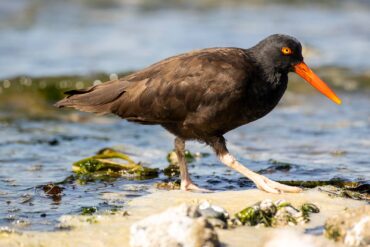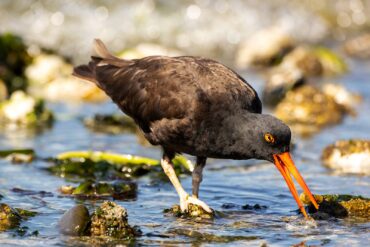
Birds are amazing creatures with a variety of adaptations. A hummingbird is quite different from an ostrich and a kiwi has little in common with a swan. While some species may seem drab and uninteresting, others are a collection of unique features that even a nonbirder would notice.
Here in West Sound, resident birds may seem unremarkable. But there are many well-known, eye-catching species, such as wood duck, Anna’s hummingbird, bald eagle, pileated woodpecker and western tanager for the most part. And there are other local show stoppers that may require greater effort to find, including Townsend’s warbler, Lazuli bunting and black oystercatcher.
A little known bird of the region, the black oystercatcher is one of the largest shorebirds of North America. Possessing an array of unique features, it is nearly impossible to be mistaken for another species. About the size of a large crow, it has brownish-black feathers, pink legs, a long and bright orange bill and yellow eyes.
A fan favorite, the black oystercatcher is highly sought after by birders visiting the West Coast from other regions. Although it’s hard to miss, this uncommon bird can be difficult to find.
There are 12 species of oystercatchers in the world, all of which have a similar appearance. They are found on every continent except Antarctica.
A nonmigratory Pacific Coast resident of North America, the black oystercatcher inhabits rocky shorelines along the outer and inner coast. Its range extends from the Aleutian Islands in the north to Baja California in the south. Its southern range overlaps with that of its slightly larger cousin, the American oystercatcher, and the two species sometimes hybridize.
Occasionally found on sandy beaches, the black oystercatcher prefers rocky shorelines and outcroppings, jetties and cobblestone beaches. Fort Flagler State Park near Port Townsend and Salt Creek County Park outside of Port Angeles offer some of Washington’s best viewing of the big black shorebird. Closer to home, Port Gamble and the shores and outcroppings of southeastern Bainbridge Island offer the best chances of seeing one. Other possible locations include the cobblestone beaches around Foulweather Bluff near Hansville.
A poorly named species, the black oystercatcher rarely eats oysters. It would be more appropriately called a “limpet catcher.” Using its trademark bill as a chisel, the black oystercatcher pries limpets off rocks at low tide, then devours the unsuspecting critter straight out of its shell in a single gulp.

Mussels are another favorite food. A well-positioned jab opens the shell, exposing the meat inside. This is more easily done as waves wash over mussels. Thus, oystercatchers often feed at rising and falling tides. Other mollusks, crustaceans and worms are also on a black oystercatcher’s menu.
The black oystercatcher is usually found in pairs or small groups. Its rapid, high-pitched whistle can grab anyone’s attention, as no other bird on the beach calls so loudly when taking off and coming in for a landing.
In late spring, the monogamous black oystercatcher pair nests on the beach above the high-tide line where a clutch of two or three eggs resemble rocks in a shallow scrape on the ground. The same site is used each year. The well-camouflaged nest lined with pebbles and seashell fragments protects the eggs from potential predators while the parents are foraging. But unaware kayakers and beach walkers may accidentally crush the eggs by stepping on the nearly invisible nest.
Both parents incubate the clutch for up to a month. While other shorebird chicks immediately start feeding on their own, oystercatcher parents bring food to their hatchlings for at least a month. When they are 5 weeks old, the fledglings can fly and feed themselves. Juveniles learn foraging techniques by staying close to their parents for several months.
The global black oystercatcher population is thought to be about 10,000 breeding birds; 80% of them live along the coast of Alaska and British Columbia. Due to the limited habitat in Washington, the state’s population is estimated to be about 400 birds.
Like other marine species, the black oystercatcher is highly susceptible to habitat disturbance. Oil spills are the biggest threat, as are other forms of pollution within the intertidal zone that create toxic feeding grounds. Introduced species, such as rats and foxes, sometimes decimate oystercatcher populations on remote Alaska islands and feral cats cause problems in Baja California. Rising sea levels may also threaten nests that are too close to the waterline. Because of the bird’s vulnerability, multiple conservation organizations list the black oystercatcher as a species of high concern.
One of Washington’s most unique birds, the black oystercatcher is a real attention catcher and an indicator species. Its presence provides a measuring rod for the health of the intertidal zone in an ever-changing world. An entertaining bird to watch, a black oystercatcher sighting is a memorable experience.





























